Peugeot 308 CC 2013.5 - RHD (UK. Australia) Owner's Guide
Manufacturer: PEUGEOT, Model Year: 2013.5, Model line: 308 CC, Model: Peugeot 308 CC 2013.5Pages: 268, PDF Size: 16.54 MB
Page 21 of 268
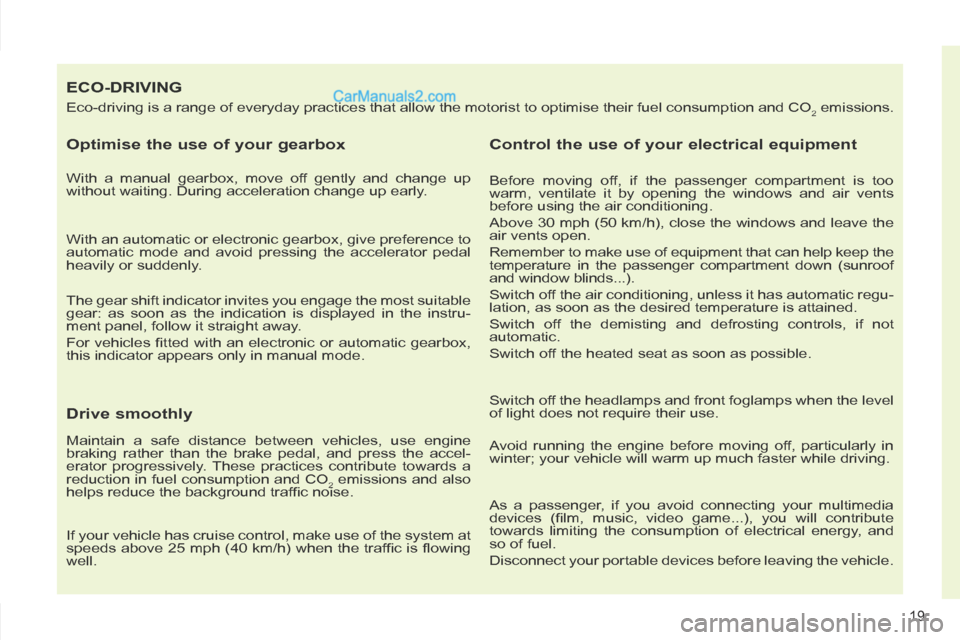
19
ECO-DRIVING
Eco-driving is a range of everyday practices that allow the motorist to \
optimise their fuel consumption and CO2 emissions.
Optimise the use of your gearbox
With a manual gearbox, move off gently and change up
without waiting. During acceleration change up early.
With an automatic or electronic gearbox, give preference to
automatic mode and avoid pressing the accelerator pedal
heavily or suddenly.
The gear shift indicator invites you engage the most suitable
gear: as soon as the indication is displayed in the instru-
ment panel, follow it straight away.
For vehicles fi tted with an electronic or automatic gearbox,
this indicator appears only in manual mode.
Drive smoothly
Maintain a safe distance between vehicles, use engine
braking rather than the brake pedal, and press the accel-
erator progressively. These practices contribute towards a
reduction in fuel consumption and CO
2 emissions and also
helps reduce the background traffi c noise.
If your vehicle has cruise control, make use of the system at
speeds above 25 mph (40 km/h) when the traffi c is fl owing
well.
Control the use of your electrical equipment
Before moving off, if the passenger compartment is too
warm, ventilate it by opening the windows and air vents
b efore using the air conditioning.
Above 30 mph (50 km/h), close the windows and leave the
air vents open.
Remember to make use of equipment that can help keep the
temperature in the passenger compartment down (s unroof
and window blinds...).
Switch off the air conditioning, unless it has automatic regu-
lation, as soon as the desired temperature is attained.
Switch off the demisting and defrosting controls, if not
a utomatic.
Switch off the heated seat as soon as possible.
Switch off the headlamps and front foglamps when the level
of light does not require their use.
Avoid running the engine before moving off, particularly in
winter; your vehicle will warm up much faster while driving.
As a passenger, if you avoid connecting your multimedia
devices (fi lm, music, video game...), you will contribute
t owards limiting the consumption of electrical energy, and
so of fuel.
Disconnect your portable devices before leaving the vehicle.
Page 22 of 268
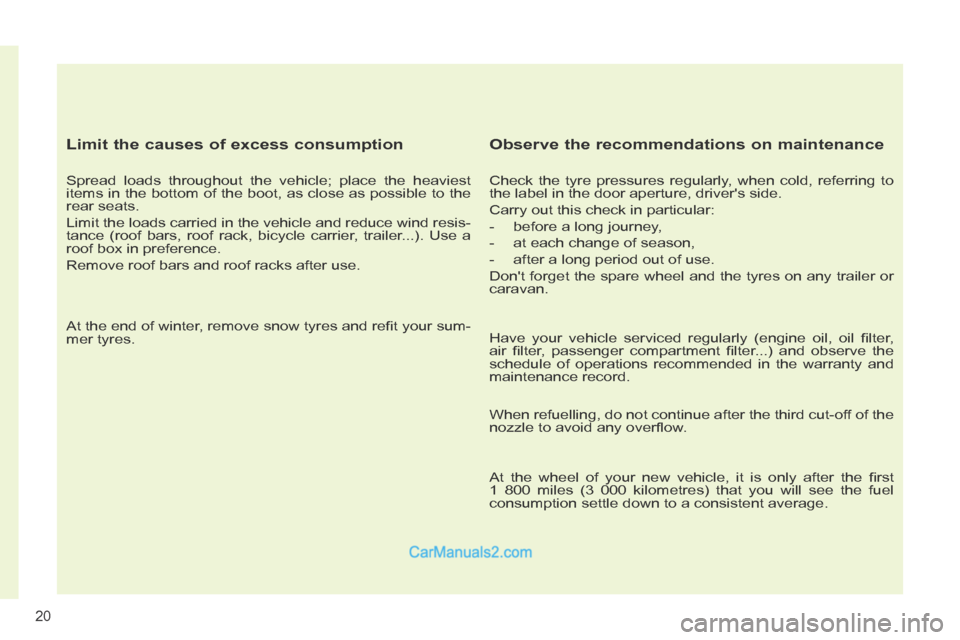
20
Limit the causes of excess consumption
Spread loads throughout the vehicle; place the heaviest
items in the bottom of the boot, as close as possible to the
rear seats.
Limit the loads carried in the vehicle and reduce wind resis-
tance (roof bars, roof rack, bicycle carrier, trailer...). Use a
roof box in preference.
Remove roof bars and roof racks after use.
At the end of winter, remove snow tyres and refi t your sum-
mer tyres.
Observe the recommendations on maintenance
Check the tyre pressures regularly, when cold, referring to
the label in the door aperture, driver's side.
Carry out this check in particular:
- before a long journey,
- at each change of season,
- after a long period out of use.
Don't forget the spare wheel and the tyres on any trailer or
caravan.
Have your vehicle serviced regularly (engine oil, oil fi lter,
air fi lter, passenger compartment fi lter...) and observe the
schedule of operations recommended in the warranty and
maintenance record.
When refuelling, do not continue after the third cut-off of the
nozzle to avoid any overfl ow.
At the wheel of your new vehicle, it is only after the fi rst
1 800 miles (3 000 kilometres) that you will see the fuel
c onsumption settle down to a consistent average.
Page 23 of 268
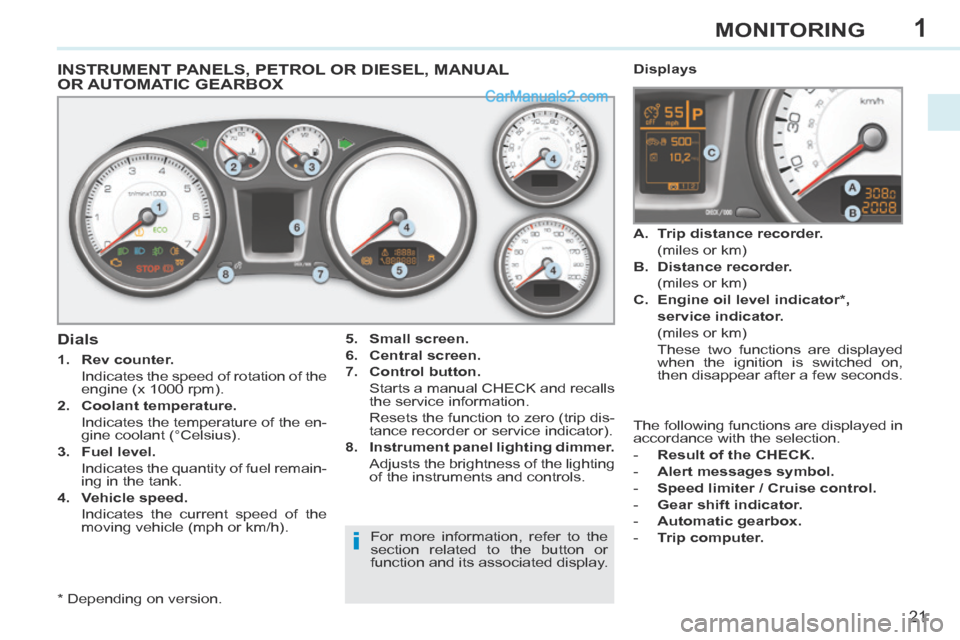
1
i
21
MONITORING
INSTRUMENT PANELS, PETROL OR DIESEL, MANUAL OR AUTOMATIC GEARBOX
5. Small screen.
6. Central screen.
7. Control button.
Starts a manual CHECK and recalls the service information.
Resets the function to zero (trip dis- tance recorder or service indicator).
8. Instrument panel lighting dimmer.
Adjusts the brightness of the lighting of the instruments and controls. Dials
1. Rev counter.
Indicates the speed of rotation of the engine (x 1000 rpm).
2. Coolant temperature.
Indicates the temperature of the en- gine coolant (°Celsius).
3. Fuel level.
Indicates the quantity of fuel remain- ing in the tank.
4. Vehicle speed.
Indicates the current speed of the moving vehicle (mph or km/h). A. Trip distance recorder.
(miles or km)
B. Distance recorder.
(miles or km)
C. Engine oil level indicator * ,
service indicator.
(miles or km)
These two functions are displayed when the ignition is switched on,
then disappear after a few seconds.
Displays
For more information, refer to the
section related to the button or
function and its associated display. The following functions are displayed in
accordance with the selection.
- Result of the CHECK.
- Alert messages symbol.
- Speed limiter / Cruise control.
- Gear shift indicator.
- Automatic gearbox.
- Trip computer.
* Depending on version.
Page 24 of 268
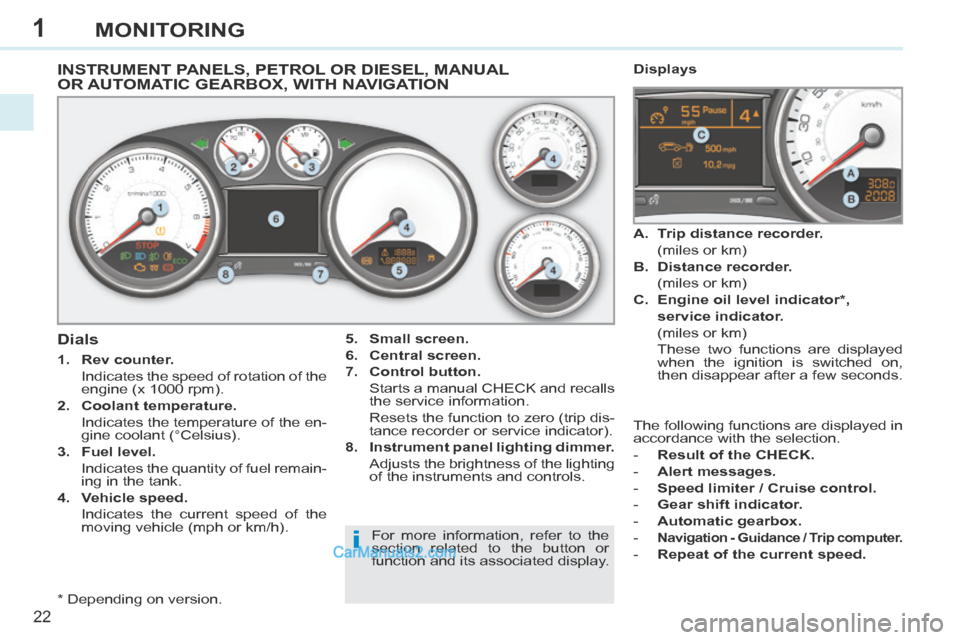
1
i
22
MONITORING
INSTRUMENT PANELS, PETROL OR DIESEL, MANUAL OR AUTOMATIC GEARBOX, WITH NAVIGATION
* Depending on version.
Dials
1. Rev counter.
Indicates the speed of rotation of the engine (x 1000 rpm).
2. Coolant temperature.
Indicates the temperature of the en- gine coolant (°Celsius).
3. Fuel level.
Indicates the quantity of fuel remain- ing in the tank.
4. Vehicle speed.
Indicates the current speed of the moving vehicle (mph or km/h). 5. Small screen.
6. Central screen.
7. Control button.
Starts a manual CHECK and recalls
the service information.
Resets the function to zero (trip dis- tance recorder or service indicator).
8. Instrument panel lighting dimmer.
Adjusts the brightness of the lighting of the instruments and controls.
For more information, refer to the
section related to the button or
function and its associated display. Displays
A. Trip distance recorder.
(miles or km)
B. Distance recorder.
(miles or km)
C. Engine oil level indicator * ,
service indicator.
(miles or km)
These two functions are displayed when the ignition is switched on,
then disappear after a few seconds.
The following functions are displayed in
accordance with the selection.
- Result of the CHECK.
- Alert messages.
- Speed limiter / Cruise control.
- Gear shift indicator.
- Automatic gearbox.
-
Navigation - Guidance / Trip computer.
- Repeat of the current speed.
Page 25 of 268
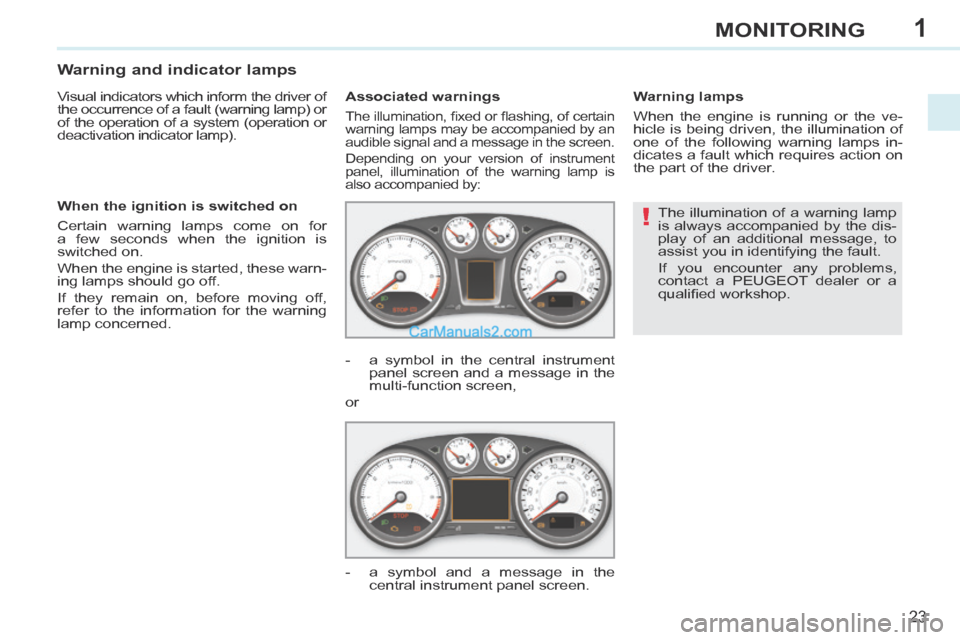
1
!
23
MONITORING
The illumination of a warning lamp
is always accompanied by the dis-
play of an additional message, to
assist you in identifying the fault.
If you encounter any problems,
contact a PEUGEOT dealer or a
qualifi ed workshop.
Warning and indicator lamps
Visual indicators which inform the driver of
the occurrence of a fault (warning lamp) or
of the operation of a system (operation or
deactivation indicator lamp). Associated warnings
The illumination, fi xed or fl ashing, of certain
warning lamps may be accompanied by an
audible signal and a message in the screen.
Depending on your version of instrument
panel, illumination of the warning lamp is
also accompanied by:
When the ignition is switched on
Certain warning lamps come on for
a few seconds when the ignition is
switched on.
When the engine is started, these warn-
ing lamps should go off.
If they remain on, before moving off,
refer to the information for the warning
lamp concerned. Warning lamps
When the engine is running or the ve-
hicle is being driven, the illumination of
one of the following warning lamps in-
dicates a fault which requires action on
the part of the driver.
- a symbol in the central instrument panel screen and a message in the
multi-function screen,
or
- a symbol and a message in the central instrument panel screen.
Page 26 of 268
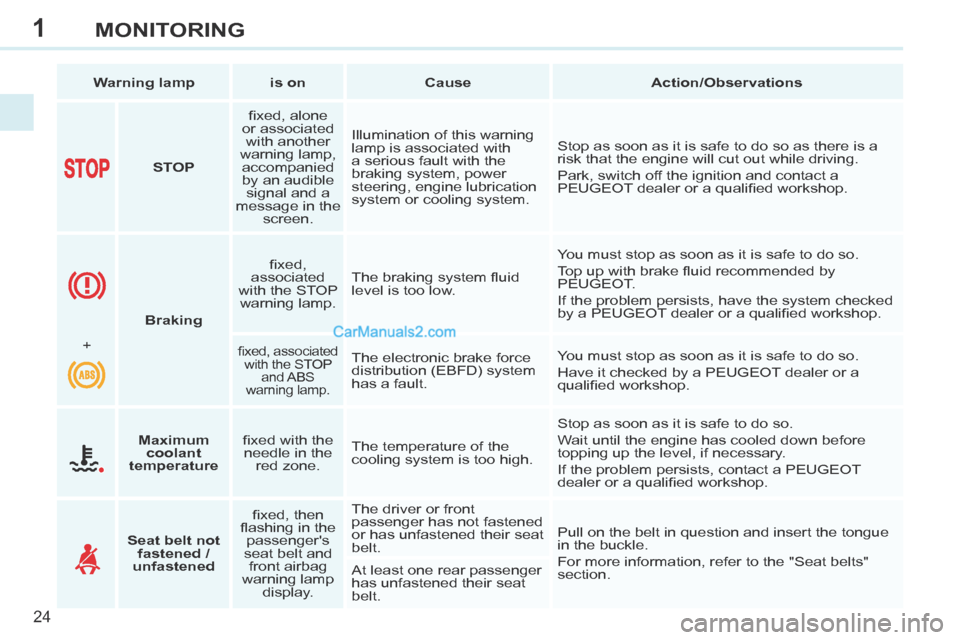
1
24
MONITORING
Warning lamp is on Cause Action/Observations
STOP fi xed, alone
or associated with another
warning lamp, accompanied
by an audible signal and a
message in the screen. Illumination of this warning
lamp is associated with
a serious fault with the
braking system, power
steering, engine lubrication
system or cooling system.
Stop as soon as it is safe to do so as there is a
risk that the engine will cut out while driving.
Park, switch off the ignition and contact a
PEUGEOT dealer or a qualifi ed workshop.
Braking fi xed,
associated
with the STOP warning lamp. The braking system fl uid
level is too low. You must stop as soon as it is safe to do so.
Top up with brake fl uid recommended by
PEUGEOT.
If the problem persists, have the system checked
by a PEUGEOT dealer or a qualifi ed workshop.
+
fi xed, associated with the STOP and ABS
warning lamp. The electronic brake force
distribution (EBFD) system
has a fault. You must stop as soon as it is safe to do so.
Have it checked by a PEUGEOT dealer or a
qualifi ed workshop.
Maximum
coolant
temperature fi xed with the
needle in the red zone. The temperature of the
cooling system is too high. Stop as soon as it is safe to do so.
Wait until the engine has cooled down before
topping up the level, if necessary.
If the problem persists, contact a PEUGEOT
dealer or a qualifi ed workshop.
Seat belt not fastened /
unfastened fi xed, then
fl ashing in the passenger's
seat belt and front airbag
warning lamp display. The driver or front
passenger has not fastened
or has unfastened their seat
belt.
Pull on the belt in question and insert the tongue
in the buckle.
For more information, refer to the "Seat belts"
section.
At least one rear passenger
has unfastened their seat
belt.
Page 27 of 268
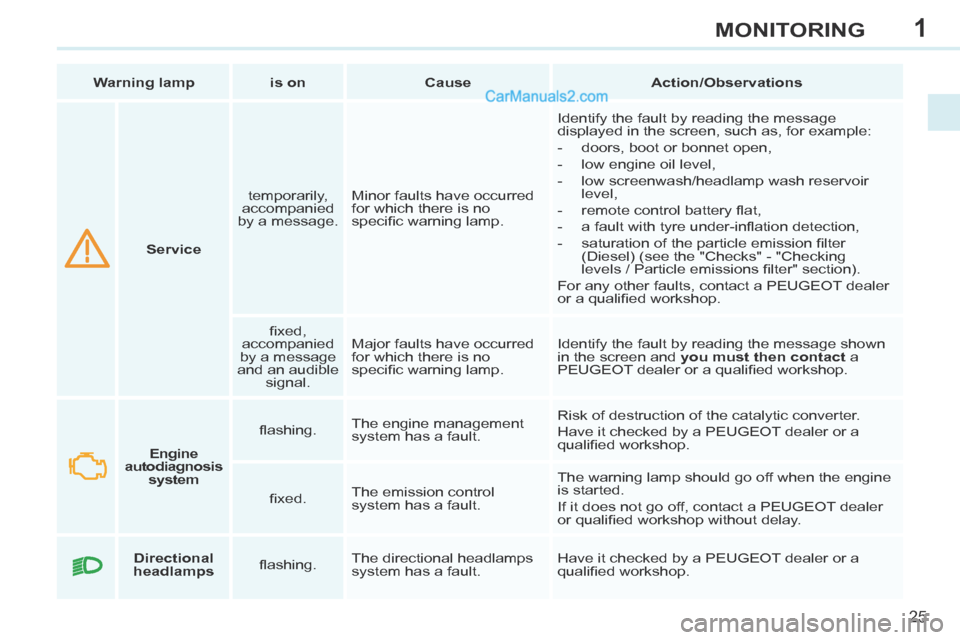
1
25
MONITORING
Service temporarily,
accompanied
by a message. Minor faults have occurred
for which there is no
specifi c warning lamp. Identify the fault by reading the message
displayed in the screen, such as, for example:
- doors, boot or bonnet open,
- low engine oil level,
- low screenwash/headlamp wash reservoir
level,
- remote control battery fl at,
- a fault with tyre under-infl ation detection,
- saturation of the particle emission fi lter (Diesel) (see the "Checks" - "Checking
levels / Particle emissions fi lter" section).
For any other faults, contact a PEUGEOT dealer
or a qualifi ed workshop.
fi xed,
accompanied
by a message
and an audible signal. Major faults have occurred
for which there is no
specifi c warning lamp.
Identify the fault by reading the message shown
in the screen and
you must then contact a
PEUGEOT dealer or a qualifi ed workshop.
Warning lamp
is on Cause Action/Observations
Engine
autodiagnosis system fl ashing.
The engine management
system has a fault. Risk of destruction of the catalytic converter.
Have it checked by a PEUGEOT dealer or a
qualifi ed workshop.
fi xed. The emission control
system has a fault. The warning lamp should go off when the engine
is started.
If it does not go off, contact a PEUGEOT dealer
or qualifi ed workshop without delay.
Directional
headlamps fl ashing. The directional headlamps
system has a fault. Have it checked by a PEUGEOT dealer or a
qualifi ed workshop.
Page 28 of 268
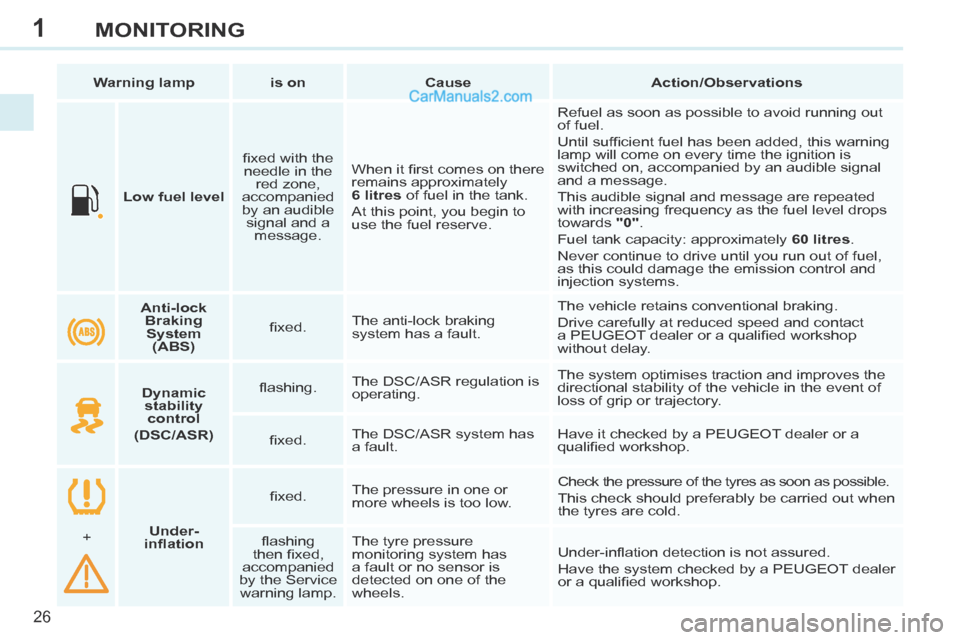
1
26
MONITORING
Low fuel level fi xed with the
needle in the red zone,
accompanied
by an audible signal and a message. When it fi rst comes on there
remains approximately
6 litres of fuel in the tank.
At this point, you begin to
use the fuel reserve. Refuel as soon as possible to avoid running out
of fuel.
Until suffi cient fuel has been added, this warning
lamp will come on every time the ignition is
switched on, accompanied by an audible signal
and a message.
This audible signal and message are repeated
with increasing frequency as the fuel level drops
towards
"0" .
Fuel tank capacity: approximately 60 litres .
Never continue to drive until you run out of fuel,
as this could damage the emission control and
injection systems.
Warning lamp
is on Cause Action/Observations
Anti-lock
Braking System (ABS) fi xed.
The anti-lock braking
system has a fault. The vehicle retains conventional braking.
Drive carefully at reduced speed and contact
a PEUGEOT dealer or a qualifi ed workshop
without delay.
Dynamic
stability control
(DSC/ASR) fl ashing.
The DSC/ASR regulation is
operating. The system optimises traction and improves the
directional stability of the vehicle in the event of
loss of grip or trajectory.
fi xed. The DSC/ASR system has
a fault. Have it checked by a PEUGEOT dealer or a
qualifi ed workshop.
Under-
infl ation fi xed.
The pressure in one or
more wheels is too low. Check the pressure of the tyres as soon as possible.
This check should preferably be carried out when
the tyres are cold.
+ fl ashing
then fi xed,
accompanied
by the Service warning lamp. The tyre pressure
monitoring system has
a fault or no sensor is
detected on one of the
wheels.
Under-infl ation detection is not assured.
Have the system checked by a PEUGEOT dealer
or a qualifi ed workshop.
Page 29 of 268
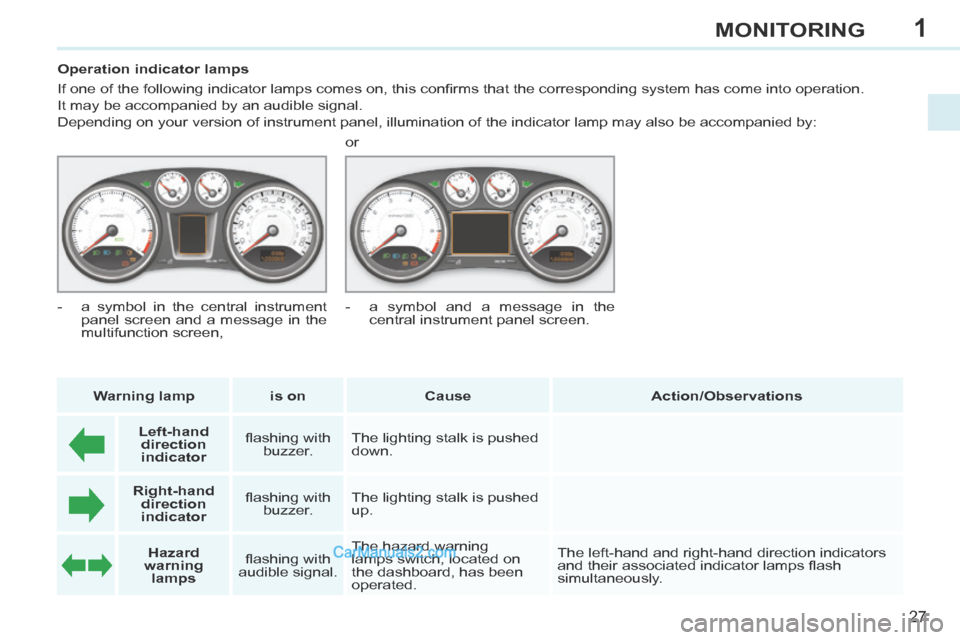
1
27
MONITORING
Operation indicator lamps
If one of the following indicator lamps comes on, this confi rms that the corresponding system has come into operation.
It may be accompanied by an audible signal.
Depending on your version of instrument panel, illumination of the indic\
ator lamp may also be accompanied by: Warning lamp is on Cause Action/Observations
Left-hand
direction
indicato r fl ashing with
buzzer. The lighting stalk is pushed
down.
Right-hand
direction
indicator fl ashing with
buzzer. The lighting stalk is pushed
up.
Hazard
warning lamps fl ashing with
audible signal. The hazard warning
lamps switch, located on
the dashboard, has been
operated. The left-hand and right-hand direction indicators
and their associated indicator lamps fl ash
simultaneously.
- a symbol in the central instrument
panel screen and a message in the
multifunction screen, or
- a symbol and a message in the
central instrument panel screen.
Page 30 of 268
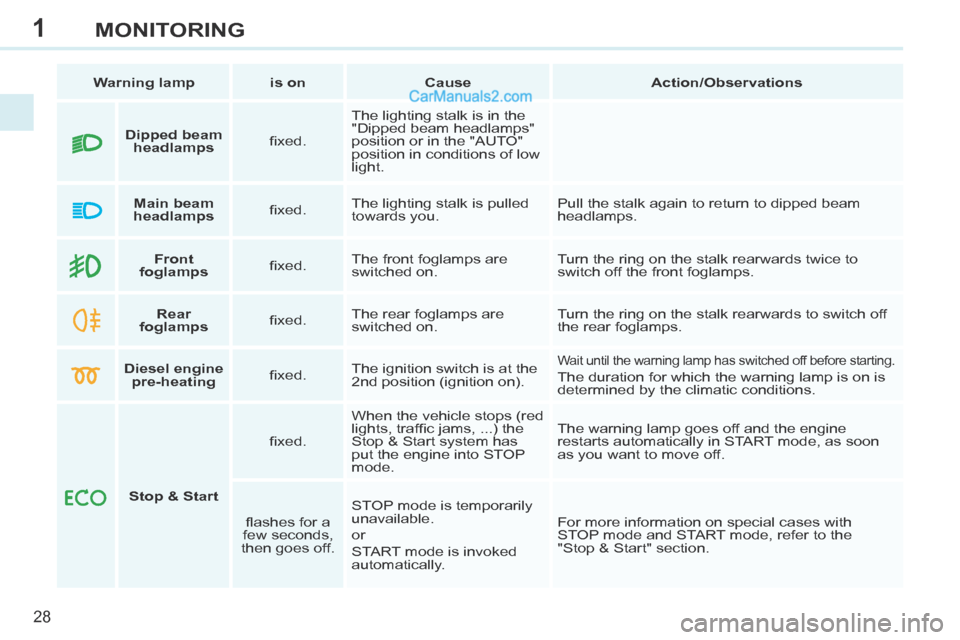
1
28
MONITORING
Warning lamp is on Cause Action/Observations
Front
foglamps fi xed. The front foglamps are
switched on. Turn the ring on the stalk rearwards twice to
switch off the front foglamps.
Rear
foglamps fi xed. The rear foglamps are
switched on. Turn the ring on the stalk rearwards to switch off
the rear foglamps.
Diesel engine
pre-heating fi xed. The ignition switch is at the
2nd position (ignition on).
Wait until the warning lamp has switched off before starting.
The duration for which the warning lamp is on is
determined by the climatic conditions.
Stop & Start fi xed.
When the vehicle stops (red
lights, traffi c jams, ...) the
Stop & Start system has
put the engine into STOP
mode. The warning lamp goes off and the engine
restarts automatically in START mode, as soon
as you want to move off.
fl ashes for a
few seconds,
then goes off. STOP mode is temporarily
unavailable.
or
START mode is invoked
automatically. For more information on special cases with
STOP mode and START mode, refer to the
"Stop & Start" section.
Dipped beam
headlamps fi xed. The lighting stalk is in the
"Dipped beam headlamps"
position or in the "AUTO"
position in conditions of low
light.
Main beam
headlamps fi xed. The lighting stalk is pulled
towards you. Pull the stalk again to return to dipped beam
headlamps.